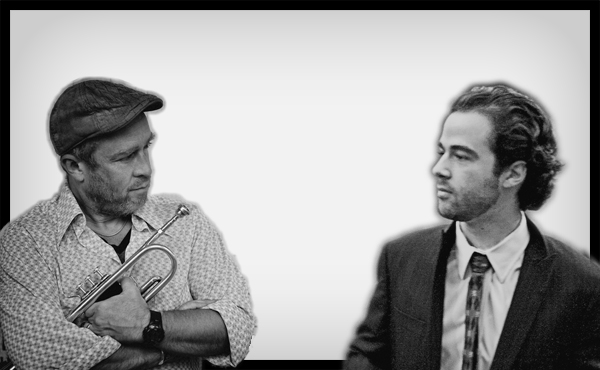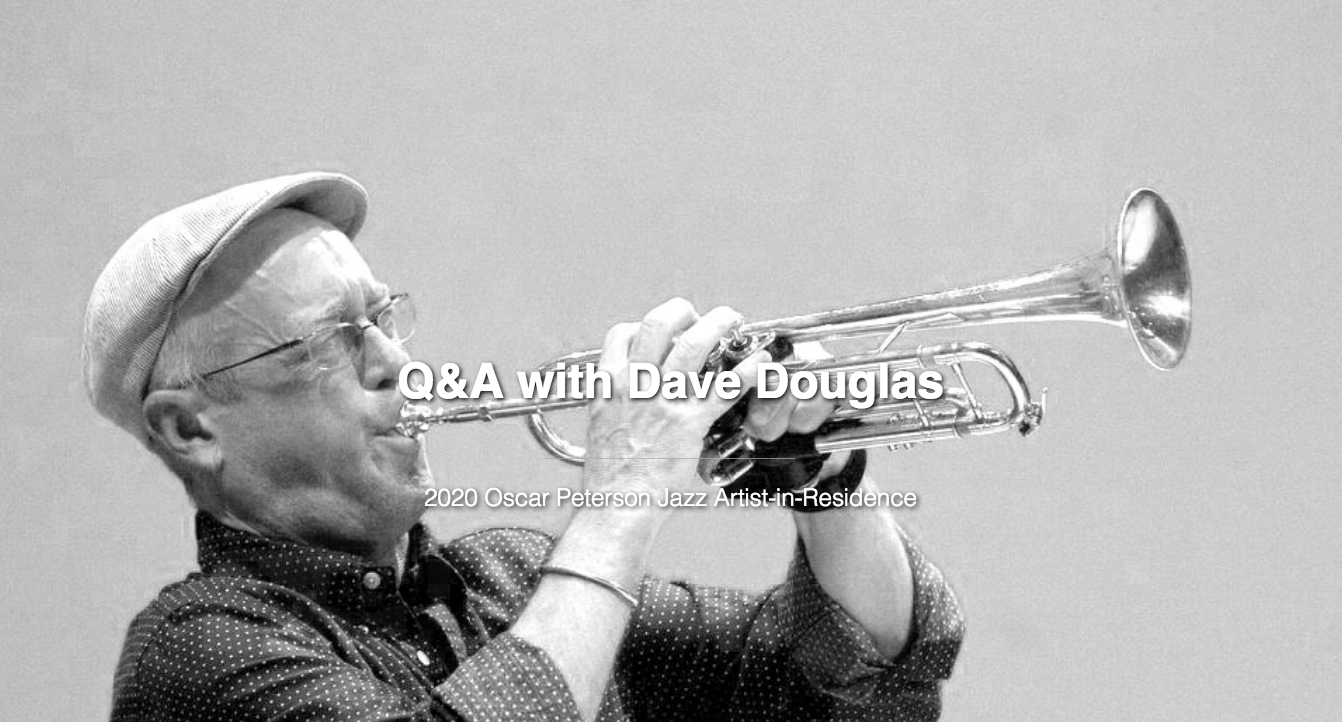Dave Douglas and Curtis Macdonald: Q&A & Q&A
Dave asks Curtis.
DDQ: What do you consider the relationship, if any, between your music for saxophone and bands and your computer-created “from the box” music?
CMA: To me, composing “in the box” is not so different than composing “on the page”. Performance and improvisational considerations must still be taken into account. This proves the need to imagine form; how will it all take shape? In all cases, I trust my ears in the final say-so. If one were to rely on the ears of a computer, the music would sound more like white noise. I feel that “computer-created” music is a misnomer, as it always requires the knowledge and aesthetic of humans in order to generate any worthy output.
As a tangent to that idea, teaching a computer how to improvise is only in some ways possible, as it will always lack intuition. Its biggest strength is how it performs pragmatic routines. Even “interactive” computer-music is limited to if/then functionality. Computers need to be spoon-fed information very clearly with defined variables and parameters. They have a language, yet sometimes language needs to be put aside in order to let the creativity in…
When I’m composing for a band I treat the computer as a tool to model ideas. Metaphorically speaking, I throw a can of paint onto the screen and start brushing by hand, learning and discovering as I go. Once I’m happy with the design, I translate it into notation, bring it before a band and forget that it ever touched a computer – making adjustments as needed.
When I’m composing a piece for film, dance or other non-improvised music, I get very detail oriented in order to yield the most control and variance in the sound. I am also conscious of “default” settings, and have developed a practice of manually adjusting common parameters; i.e. I rarely use a rigid tempo map, and always play with articulation, transients and envelopes to program as much humanistic nuance as possible. This largely relates to the processes of arranging and orchestration at the micro-level.
Both analog & digital mindsets have something in common; the idea of squeezing as much information out of source material as possible.
DDQ: OK, poor choice of words on my part. By “computer-created” I didn’t mean that the computer actually creates the music. What I meant (and you’ve spoken to some of this) was the music that you make in solitude–you and the nonhuman computer–as opposed to music you write out to be played by human musicians. There must be a major divergence between the way you think about what goes on the page for a band and what goes on on the screen in your dance scores and film pieces. To me, the basic difference there is that there is no improvisation in the latter; once the piece is done it is simply performed by the computer or digital device. In the former the information you give to human beings can only be an approximation of the final result. Does this dichotomy affect process for you?
CMA: Yes, the dichotomy is a macro vs micro perspective shift. With performing musicians, I provide macro information (the form, an initial direction) and with performing computers I provide micro information (all the nuance and subtleties). The difference is feel. Composing on a computer with a sense of feel is where one’s musical and emotional experience comes into play.
Additionally, computers are a powerful tool in that you can manipulate and instantly hear back your concoctions. In “Composing Interactive Music” Tom Winkler says a few things along these lines:
“Composers have always used processes to generate large musical structures from simple musical material… Many types of musical processes can be easily represented in software by an algorithm, step-by-step instructions used to accomplish a specific task… This immediacy in generating and manipulating musical materials provides the composer with an interactive laboratory where musical ideas and time-varying compositional processes are quickly realized and refined. The benefit of getting immediate aural feedback from this kind of experimentation cannot be overemphasized. Within this laboratory environment composers can generate scores for acoustic works, create situations for improvisation with other musicians, or compose solo pieces to be played directly from the computer.”
I think it’s similar to how a modern architect creates their plans. A blueprint model is drawn up digitally, taking into account all organic things that exist in our world: environment, building materials, climate, load, etc. It’s then built underneath the direction of an engineer, (the performer in our case). During construction, the engineer may interpret or adjust the plans somewhat, and this may inform the architect of a required amendment or revision in the design.
DDQ: “squeezing as much information out of source material as possible,” I like that idea. But when you deal with live musicians isn’t the process more, well, complex?
CMA: Actually, I feel that the process when working with computers is more complex than working with real, live people. Telling a computer to perform in such a way is a technically complex process, whereas giving a skilled, experienced musician a set of guidelines or source material is rather straightforward. Of course, bringing a band to a level of ensemble where a collective synergy has been developed is a phenomenon of group dynamics, which is either a complex, or simple undertaking depending on how you perceive it. Generally speaking, I find that source material is expanded and developed naturally among musicians, whereas on a computer the development of a source material must be programmed, with added layers of complexity to create the desired results.
DDQ: To shift gears a little, then: Does your work with computers have any effect on the way your write tunes for your band? It’s interesting to hear that the music you create on the computer requires an additional layer of complexity in order to develop. Do you consider that added layer of complexity in thinking about how musicians will respond to your pieces for the band? And what about you as a saxophonist: How does this compositional process affect the way you practice and play?
CMA: I think one of the best things about working with a computer is that you can model ideas that are not yet technically available to you on a instrument. Programming helps me make imagined or theoretical material more concrete and easier to grasp. This way, the computer is a great practice tool – by changing just one variable there is more territory to explore. I first play with an idea digitally to understand the concept and then choose to adopt it in some way into my playing.
Dealing in complex terms on a computer often means working in simple terms for musicians. When I bring music to the band, I have imagined what roles the musicians can fulfill. But when it comes time to play, I forget that the music was ever on a computer and we make it our own. Musicians will always respond to the material in a complex way, it’s in their nature. It only requires grasping the overall arc of the piece, which is something that even as a composer I rediscover each time we play.
Curtis asks Dave.
CMQ: What routines do you put yourself in when you’re deep in composition mode? What tricks, if any do you try when you hit a road-block, or need more material, etc? What editing processes do you exercise?
DDA: First of all I throw out everything that I think I know and try to deal with the material as internally and honestly as I can. But I don’t want to pontificate here. It’s still really difficult.
I’ve always loved this quote from Anthony Braxton and used to keep it over my work table.
“Since coming into academia, I came to understand very early that I would have to build an alternative system to help me, because in academia you’re constantly talking about your music and that’s dangerous. You’re constantly talking about the science of the music in a two-dimensional way. So I started to move the ray of focus in my model into the poetic logics, as a way to not know what I’m doing. Because I’m not interested in a music that’s two-dimensional, that I can talk about as being the “it” of the music. By that I’m saying that I want the undefined component of my music to be on an equal par with the defined component.”
There are not really any tricks because any technique that gets you past a road block is composition.
Last year I asked a group of students in Holland what they do to overcome writer’s block and one of them said, “Drinking!”
He would certainly have a lot of company among composers.
Bottom line, it ain’t easy and it takes a painstaking examination of biases and limitations and a funneling and winnowing of what we want to say.
One of my favorite books about composition is Strunk and White’s Elements of Style. For example, they say:
“Clarity, clarity, clarity. When you become hopelessly mired in a sentence, it is best to start fresh; do not try to fight your way through against terrible odds of syntax. Usually what is wrong is that the construction has become too involved at some point; the sentence needs to be broken apart and replaced by two or more shorter sentences.”
“Muddiness is not merely a disturber of prose, it is also a destroyer of life, of hope: death on the highway caused by a misplaced phrase in a well-intentioned letter, anguish of a traveler expecting to be met at a railroad station and not being met because of a slipshod telegram. Think of the tragedies rooted in ambiguity, and be clear! When you say something, make sure you have said it. The chances of your having said it are only fair.”
Sometimes stepping away from a work to consider all the elements is the only way to make sure we are getting at what needs to be got at.
CMQ: In regards to Braxton’s quote, what do you leave “defined” in the bandstand? What do you leave “undefined”?
DDA: Well if I could answer that it would defeat the purpose, wouldn’t it?
To me, that quotation is powerful because it is a reminder that many of the forces in motion in music are beyond our rational control. Especially when we begin to talk about music, which I believe is important to do, it’s easy to lose sight of the mystery in creation. The unknown quotient is a major element in music whether we like it or not.
So, yes, work hard on your music and defining the contours as much as you can. But also respect the inevitable unknowns at work and leave them a place at the table.
Accept that some of the elements you think have defined may become undefined in the crucible of performance. Accept that some elements you think are mysterious and unknown may become obvious and repeatable after one reading.
CMQ: I love the quote from the Elements of Style. Clarity, space and perspective seem to be somehow inter-connected… Can you talk a little about what you do (or don’t do) to ensure clarity of perspective for composition? For performance? For practice?
DDA: As I’m writing I look at the piece from as many different perspectives as I can. I have used the analogy of a sculptor. Every few cuts you step back and make a three dimensional assessment of the work from various angles.
One perspective would be that of someone asked to perform the piece. One could be an imagined audience member. Another might be an old friend. Or an enemy. A character in a novel. Et cetera.
I love languages, and the analogy of writing something that could be understood regardless of a listener’s experience with languages is another idea. Not that a listener should be absolved of all responsibility to know the language of a work, rather, that as composer/performers we have available a variety of means in the form of traditions and lineages that we can use as languages. It gives us flexibility in reaching out to a listener.
The biggest perspective would be to look at how you are using all the basic musical elements. For me, revisions most often come from an examination on that level.
Clarity is the process by which we reveal our innermost thoughts and re-write our pre-written destiny.
CM: I’m reminded of Charles Mingus’ quote: “In my music, I’m trying to play the truth of what I am. The reason it’s difficult is because I’m changing all the time.”
I like the impermanence of it all, whether it’s on page or improvised, stage or studio, everything is a fleeting moment and the beauty of improvisation is that we can paint a scene from an immense variety of perspectives and experiences. Moments of clarity are truly universal, infectious to the audience and band members alike. That’s why I continue to explore technology – to gain further clarity on musical and ultimately universal concepts. It too works in a universal language, one that can help us grasp ideas and bring them into awareness, which is a key element of my musical practice.



